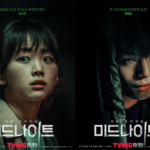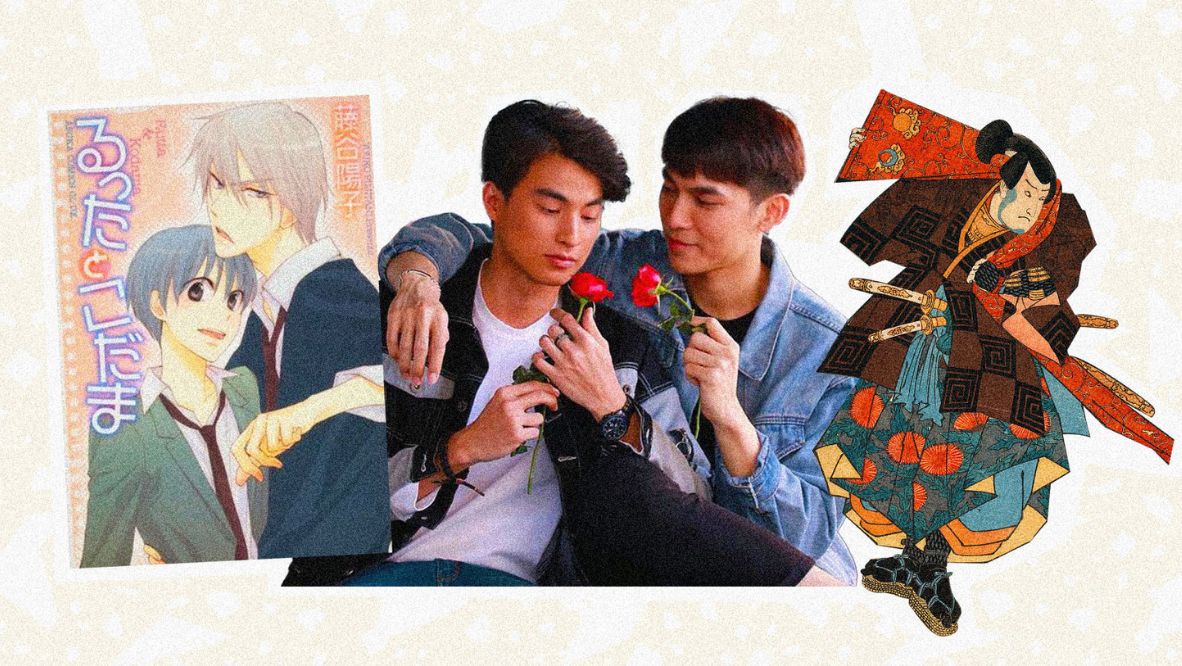
If you were told that your favourite BL drama was linked to Japan’s samurai culture and modern patriarchy, and wasn’t really pro-LGBTQ+ rights at the beginning, would you believe it?
In an era where trends dictate what netizens consume and the content on the internet is as fickle as the seasons, there’s one genre of sub-culture that has remained steadfastly popular through it all. Yes, we are talking about Boys’ Love literature, also known as BL, or formerly Yaoi.
The genre, which depicts homoerotic relationships between male characters in manga, anime, fanfiction and drama, has been taking over the world over the past decade. Take a look at the Japanese BL manga Junjo Romantica: Pure Romance, which became the first BL title to enter the New York Times manga bestseller list in 2011, or more recently the BL Thai-drama TharnType: The Series (2019), which propelled Thai icon Gulf Kanawut to global fame.
Despite being one of the fiercest contributors to Japan’s and Thailand’s soft powers, the countries don’t like to brag about it. It’s a genre which has been known to depict explicit sexual scenes, where the notion of consent is often non-existent and which can, paradoxically enough, be quite homophobic. Some countries are actively censoring the genre like China. But this hasn’t stopped the BL fanbase from growing globally since the mid-2000s. At the time, Dr Akiko Mizoguchi, a queer visual culture theorist and associate professor at Tokyo’s Waseda University, estimated in her research published in the Journal of Popular Romance Studies in 2017 that there were already one million BL fans in Japan.
Yet compared to its virality, the genre remains relatively undiscussed. The BL genre has gone through deep transformations that deserve our attention—especially related to the representation of the LGBTQ+ community. At its origin: a genre by women, for women—without women

BL literature originated in Japan, where there was a strong cultural base for it, explains Dr Kazumi Nagaike, professor at Oita University. “BL culture takes its roots in the samurai culture of pre-modern Japan,” explains Dr Nagaike. “The deep dedication that samurai men felt for each other normalised homosociality in Japanese culture.”
In the collective imagination, this same-sex dedication blossomed into “a supreme form of love”, she says. It contrasted with heterosexual relationships, which were burdened with the duty of carrying on one’s bloodline. She notes that women, in particular, were drawn to the idea of same-sex male relationships because it was free from the pressures of family, unlike male-female relationships that often came with those burdens.
In the early 1970s, triggered by Japan’s growing patriarchal system and as part of the second wave of Japanese feminism, homoerotic stories gained more and more popularity among Japanese women. First mostly written by men, women would take over as the main authors of the genre as they entered the labour market.
“First, through what we called Shonen-ai and Tanbi literature in the early 20th century, and then through Yaoi literature in the late 20th century and finally Boys’ Love and BL literature in the 21st century, women empowered themselves through [reading, writing and fantasising about] love stories that involved characters who didn’t look like them [nor had similar societal pressures].”


Depicting love between two men was a much more fun exercise than writing about heterosexual love stories, Dr Nagaike explains: in the 1970s, women were written as passive and one-dimensional characters: “So, female readers who wanted to take more ownership of their lives while dreaming of this ‘supreme form of love’ had no choice but to project themselves onto male characters,” Dr Nagaike says. “And that’s why BL stories are written by women, for women, but without women in it: it allows them to escape from their reality.”
In the late 1990s, BL literature spread to other countries such as China, South Korea, the US and Thailand with the popularisation of the internet. Fan communities shared unauthorised copies and translations online, and even started to write their own original stories on blogs.
Tatler spoke to Thai writer Jidanun Lueangpiansamut to understand how she got into this genre. The youngest-ever recipient of the SEA Write Award and Tatler’s AMI awardee says, “BL literature was a case of discovering my sexuality. Where I grew up, sex was taboo for girls. We weren’t as free as boys to learn and experiment with it. That’s why it was easier for me to create characters with gender stereotypes that I couldn’t identify with.”
Misrepresentation of gender roles and queer relationships
For the latest generations of BL writers, the interest in the genre grew through the creation of fanfictions and webtoons on the internet. “Whether it was manga, Harry Potter or K-pop bands, my generation of writers found inspiration in parasocial relationships but took it to the next level by creating original stories,” Lueangpiansamut says.
While the internet allowed creative freedom, it came with its limitations and abuses, such as misrepresentation of queer relationships, romanticisation of assaults and disrespect towards the notion of consent.
“While it doesn’t apply to all BL stories, in the pre-2008 movement, we’ve witnessed many depictions of sexual assaults and a dominant/submissive dynamic between the main characters,” explains Dr Nagaike. “Homophobia was also more prominent at that point in Japan, so it was important that at least one of the protagonists didn’t identify as gay, but would ‘be gay’ only for the other protagonist. Also, the characters were drawn in a typical bishonen way [depicted as androgynous and pretty, with western features] to look ‘attractive’ to the female readership.”
However, the evolution of gender roles and the growing acceptance of the LGBTQ+ community finally brought the genre the breath of fresh air it needed.
“In the new wave of BL culture, post-2008, we’ve witnessed a huge diversification of male characters,” Dr Nagaike says. “Less dominant/submissive dynamics, fewer pretty boys and more consent, more diversity and a more realistic depiction of same-sex relationships.”
While this new wave recognises the importance of gender equality, Lueangpiansamut adds that the movement’s structure—which is internet-based—has forced BL authors to be accountable for the stories they create: “Every author is sensitive to netizen criticism or endorsement,” she says.
With new values, better representation and more accountability, BL culture has also expanded its fanbase. This includes new demographics, like queer people, but also new countries, like Thailand—which has become the latest powerhouse for BL entertainment.
How Thailand is taking over the BL market


“The fact that BL became so big in Thailand came as a surprise to me,” says Lueangpiansamut. “I grew up looking up to Japan, and then to South Korea for this kind of content. I never thought my country was cool enough.”
Over the past years, through its artistic, musical and culinary scenes, Thailand has become one of the trendiest cultural hubs in Asia. But its “coolness” isn’t the only reason it’s been taking over the BL market: this takeover is actually a political one, according to Dr Nagaike: Thailand has been embracing women’s rights and the LGBTQ+ community over the past years, while Japan hasn’t.
“[This] allows Thailand to transcend the drawing or writing format to a live-action format—it was a great way of boosting the BL culture,” she says. “In comparison, Japan is still very traditional, even homophobic sometimes, and it has directly impacted the development of the Japanese BL scene.”

Indeed, even when they try, Japanese actors face backlash for portraying same-sex relationships and TV channels receive complaints from viewers, Dr Nagaike says. “So as long as BL stays a sub-culture in Japan, that is only accessible to informed audiences behind closed doors through manga and anime, no controversies can arise from it,” she adds.
On the contrary, in Thailand, BL dramas have become successful launchpads for actors. For instance, the hugely popular stars Vachirawit “Bright” Chivaaree, Suppasit “Mew” Jongcheveevat and many others all started their careers in BL dramas. On top of this, Thailand has actively been moving away from adapting Japanese stories to the big screen to prioritise their homegrown scripts. One of the latest examples is Lueangpiansamut’s BL story City of Stars (2024), which was recently adapted into an onscreen drama.
Dr Nagaike adds that a lot of Thai series include QR codes supporting same-sex marriage at the end of each episode, which opens up the audience of these shows. Lueangpiansamut confirms: “My original audience was mostly heterosexual girls and women, but in the past five years, I found out that more queer people have developed an interest in BL culture.”
Yet BL culture still has a long way to go, especially in terms of representation. But it will certainly follow the path of women and queer rights’ acceptance in Asia and for now, its future seems in Thailand.












